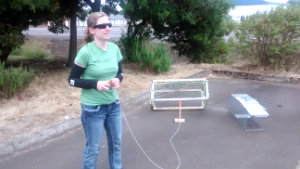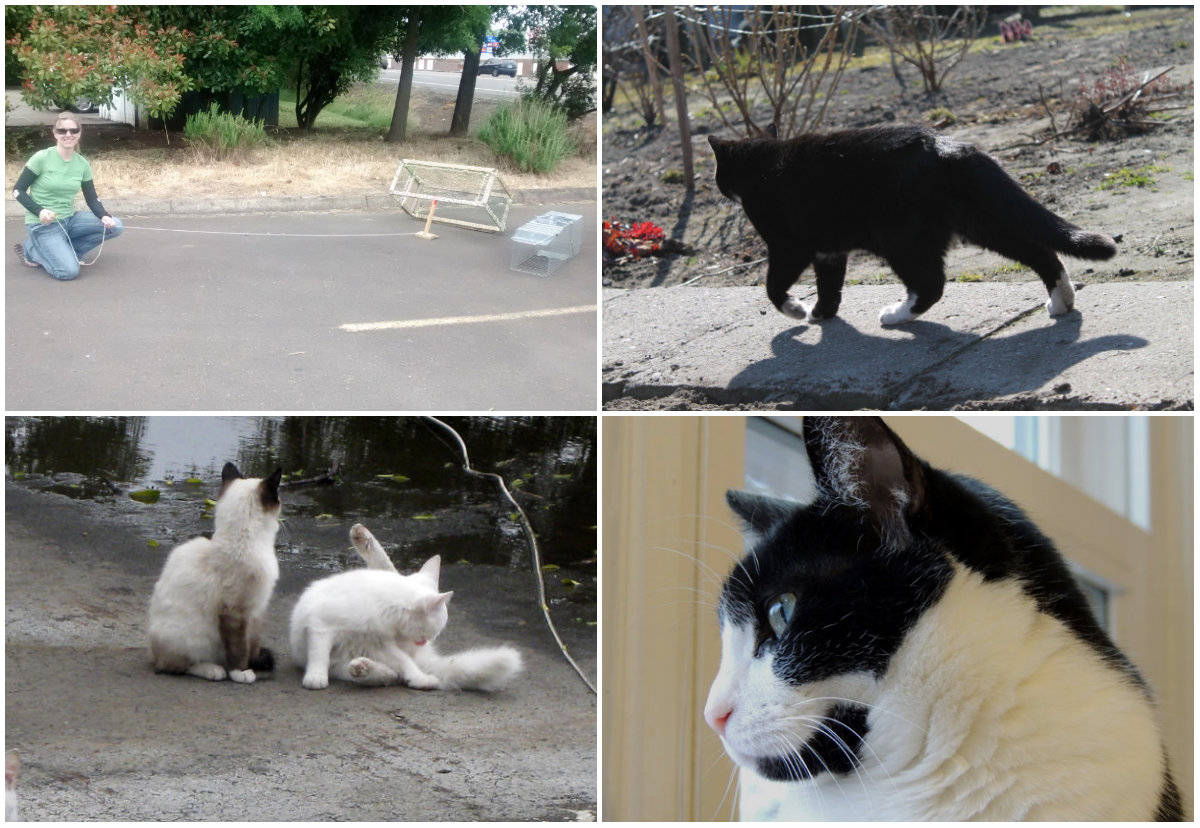By Alexandra Schaefers
 Cat-lovers often end up with one too many cats because there are so many adorable kittens in need of homes and nothing conjures up the sense of destiny quite the way a rambunctious kitten does when it suddenly stops still for a moment of unwavering eye contact with a human. And while many of us know someone who has, say, five too many cats, we have yet to be introduced to the true heroes of cat people, trappers like Stephanie Kew who devote their time and energy to spaying and neutering strays and ferals to curb the number of unwanted cats that might otherwise be euthanized.
Cat-lovers often end up with one too many cats because there are so many adorable kittens in need of homes and nothing conjures up the sense of destiny quite the way a rambunctious kitten does when it suddenly stops still for a moment of unwavering eye contact with a human. And while many of us know someone who has, say, five too many cats, we have yet to be introduced to the true heroes of cat people, trappers like Stephanie Kew who devote their time and energy to spaying and neutering strays and ferals to curb the number of unwanted cats that might otherwise be euthanized.
Kew first started trapping cats after she was laid off from her receptionist job at an engineering firm in San Francisco in 2011. She was feeding a stray on her balcony in the Concord neighborhood she was then living in when a woman who worked in cat rescue told her not to feed strays unless she had them fixed. Her neighbor then introduced her to the art of cat-trapping and a local rescue group. Kew, who has a degree in studio art from UC Davis California, got hooked on saving cats. “Once you’re a trapper,” says Kew, “it’s hard to stop. When I moved to Oregon I’m like, ‘OK, I’m going to take a break from all this…this is crazy.’ And then, of course, I saw that tuxedo cat on the railroad tracks.”
Kew moved to Oregon in 2013 and began seeing a black-and-white tuxedo cat along the railroad tracks near Highway 99 in northeast Corvallis. She began asking local businesses about the cat and before she knew it she had trapped 19 cats from a nearby colony. A colony is a group of feral cats that establish around a food source, often a well-meaning human but sometimes just a plentiful supply of rats or other wildlife. Colonies can start with just two cats, but kittens are able to have their first litter after just four months so colonies grow exponentially if unnoticed or unmanaged by humans. Kew is not at all opposed to people feeding ferals, but emphasizes how important it is to have any cat that is fed spayed or neutered. Not only does is reduce the number of unwanted kittens, it also cuts down on the yowling and scrapping of mating and fighting cats that makes them a nuisance to neighbors. It also makes the cats healthier.
When Kew traps, she heads out just before dark to an area where she’s seen cats repeatedly and sets up a trap baited with food like freshly carved turkey. She then sits in her car and reads while she waits for a cat to find the food. Some traps are set off by the cat, some Kew sets off when she sees the cat enter the trap. She then puts a towel over the mesh trap to calm the cat down and takes it home where it spends the night in a carrier until she takes it to the vet the next morning. The process can take hours with little sleep between the return home and the early morning vet visit. The vets spay or neuter the cats, treat them for worms, vaccinate them, and tip the cat’s ear, meaning they clip the point off as a universal marker to trappers that the cat has already been fixed. This is especially important with females as ferals need to be put under anesthesia just to see if they have a spay scar or not. Kittens and friendly ferals are placed in shelters or foster homes to be adopted; the rest Kew rehabilitates from surgery before releasing them back in their familiar territory.
As Kew works with a colony the process becomes more challenging; she’ll trap cats that have already been fixed and find there is some illusive momma cat she just can’t lure in. “I put a lot of pressure on myself to get every single one,” she says, “but you just have to know, we can’t save them all.”
There are plenty of other challenges. One neighbor thought Kew was removing a feral and became argumentative when she came back to release the fixed cat. She was once bitten when she got too close to a feral. Considering she’s trapped approximately 120 cats since she began, it’s safe to say she’s good at handling ferals, but wild animals will always be unpredictable. There is also the reality that some of the cats are too sick to save. “It’s super devastating, but that’s just part of it,” reflects Kew. “The silver lining is that you did the animal a favor by euthanizing it instead of letting it suffer out in the streets.” Of course, the vet bills are also a challenge. Each cat costs $100 to fix and treat. While she does get some support from concerned parties, Kew takes on a lot of this expense herself.
Currently Kew has two of her own cats, Pumpkin and Lollie, both domestic short-hair tabbies. Pumpkin was her first street rescue from San Francisco. Lollie has a tipped ear—she was a feral Kew was going to release, but she became tame after spay surgery and won Kew over. I asked her how many cats she would have if she didn’t live in an apartment with pet restrictions, imagining it would be hard to keep the numbers down; she replied that she would always keep it in the single digits so each gets the attention they deserve.
Kew’s file at Heartland Humane society is flagged “Do not euthanize,” meaning she will take on the task of finding a home for any cat she brings in if Heartland doesn’t adopt it out.
I asked Kew how she would like to see Corvallis change to become more cat-savvy. Kew replied that she wishes more vets would fix ferals, that there was a greater awareness of the need to spay and neuter all cats, and ultimately for people to realize that we can live with feral cats if they are managed properly. It’s a heated issue and she recognizes that while Corvallis tends to have a farm mentality toward getting rid of nuisance cats, she also sees that most people want to do the humane thing. She urges people to seek out other options before calling Animal Control to remove an unwanted cat. Shelters and rescue groups have good information about deterring ferals and may have connections or resources to trap and fix cats so they won’t be a nuisance. She reminds us that ferals are drawn to food sources and killing a wild cat usually just makes room for a new cat to move in.
Kew feels hopeful that as people become more educated and realize that their tax money pays to euthanize unwanted cats that more programs will start up like the one in Spartanburg, South Carolina where Animal Control officers trap and release fixed feral cats instead of euthanizing them. In the meantime she has five new kittens to trap at the northeast colony this year. Kew estimates that she knows 30 or 40 individual cats around Corvallis. “They become part of your soul,” she says. “You start to care about and love them all.”
You can learn more about deterring or living peacefully with feral cats at www.alleycat.org. Stephanie Kew takes donations for her trap-and-release efforts at Reskew Ferals, P.O. Box 1451, Corvallis, OR 97339-1451. She can also be contacted for cat-sitting services at reskewferals@yahoo.com.
Do you have a story for The Advocate? Email editor@corvallisadvocate.com


